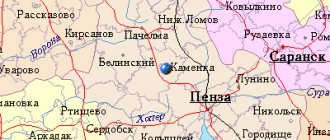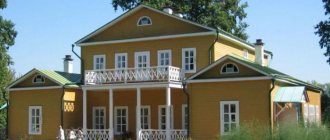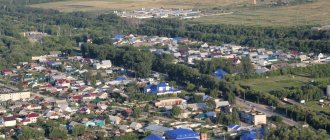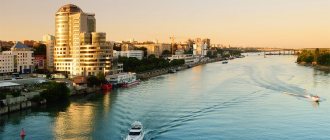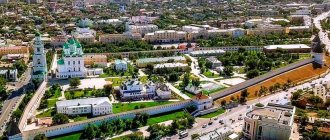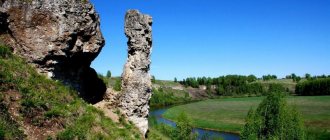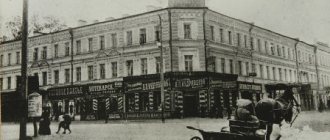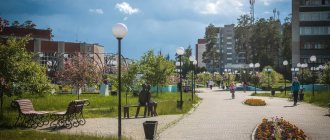The city of Penza was founded in 1663. Tourists not only from all over the country, but also from abroad come to see the sights of the Penza region, of which it is the regional center. There are many cultural and historical monuments here, in which the history of Russia is embodied, because it is not for nothing that Penza is considered the cultural center of the Volga region.
Historical facts
Penza is a city that was originally founded as a fortress to protect against attacks by nomadic steppe peoples. The location for the fortress was chosen at the confluence of the Penza and Sura rivers. Therefore, the settlement received such a name, which in translation from the Mordovian language means “swamp”, “swamp”, which is not accidental: after all, the city is located in a previously swampy lowland of the river.
For several centuries, the Penza fortress regularly fulfilled its duty as a border military settlement, and when the danger of constant invasions by nomads passed, it gradually turned into the spiritual, cultural and economic center of the region. As a result, its territory now contains many historical and architectural monuments dating back to different periods of Russian development. Therefore, tourists have something to see in the Penza region and its main city.
Tourist sites in the region
For those who like to travel across the expanses of their native country, the sights of Penza and the Penza region are of undoubted interest. In addition to beautiful natural landscapes and architectural monuments, there are unique objects that concentrate the cultural and spiritual life of the region: local history museums, as well as museums dedicated to outstanding personalities whose lives were in one way or another connected with this land; theaters; monasteries; churches.
Next to them are the best creations of modern architects, which have also become local attractions. Tourists who are tired of examining historical artifacts can visit the botanical garden, zoo, and nature reserves of the region.
State Museum of A.N. Radishcheva
State Museum of A.N. Radishcheva
Kuznetsky district
The museum is located in the restored family estate of the noble Ablyazov family, relatives of the writer and philosopher Alexander Radishchev. The stone manor house was built by the writer’s great-grandfather Grigory Ablyazov. Here Radishchev was born, spent his childhood, and later worked on the economic treatise “Description of My Possession.”
In 1736, the Transfiguration Church was built on the territory of the estate, which has survived to this day. However, the iconostasis was destroyed during the Soviet years. In the late 1990s, another one was moved here from a closed church in a neighboring village. Inside the Transfiguration Church there is a family crypt of the Radishchevs. The writer's parents, brother and youngest son are buried there.
In the 19th century, the mansion fell into disrepair and was demolished. The building was restored on the old foundation in 1995, but its exact appearance could not be repeated. Restorers used drawings and plans of other ancient estates in the Penza region. Inside, the interiors of 19th-century manor houses were reconstructed.
Today, the museum ensemble also includes the former zemstvo school in the village of Verkhnee Ablyazovo. It houses the main exhibition. Personal belongings of Radishchev and members of his family, rare lifetime publications and handwritten copies of “Journey from St. Petersburg to Moscow” are exhibited here.
Penza city
Penza is a city that takes precedence in many Russian cultural endeavors; it is famous for its unique museums. Here in 1848 the opening of the country's first hippodrome took place; in 1873 - a circus. Penza was also the city in the Russian Empire where the country's first city park was opened, called the May Garden, which is now known as Belinsky Park.
Memorial complexes
Residents of Penza and the Penza region can be proud that their region is the birthplace or place of active creative life of famous and very significant personalities for Russian culture, such as:
- M. Lermontov;
- V. Meyerhold;
- A. Radishchev;
- V. Klyuchevsky;
- V. Belinsky.
100 km from Penza is the village of Lermontovo - the former Tarkhany estate, where the great poet was born and raised. There is a museum named after him here, as well as the writer’s grave, where it was moved from Pyatigorsk, where M. Lermontov was originally buried.
The museum complex dedicated to A. Radishchev is located in the village of the same name, where there is a preserved house of the publicist, a family church and the building of a former zemstvo school with a museum exhibition housed in it.
The Meyerhold Memorial Museum is located in the former family estate that belonged to the parents of the famous innovative theater director. The museum exhibition is divided into two parts, in the first of which visitors are introduced to Meyerhold’s personal life, the second tells about his work.
The V. Klyuchevsky Museum is located in an old wooden house, in which the famous historian lived for the first twenty years. The exhibition consists of two parts: one demonstrates the everyday environment in which the scientist lived, archival documents of the 19th century; the second talks about his scientific heritage.
In the city of Belinsky (the old name is Chambar) there is a museum-estate of the literary critic V. Belinsky. The famous democratic publicist spent his childhood and adolescence here. The exhibition consists of original items from the 17th-19th centuries, a large library, a cinema hall and a lecture room, and is housed in a complex of three buildings: the writer’s family house; merchant mansion; former zemstvo school.
The city also has attractions that are not historical, but simply decorate the city with their originality and make it more alive. Such decorations include, for example, the “Tree-Traffic Light” art object. Installed on one of the streets, the “tree” was created from outdated but still working traffic lights. It is very popular not only among tourists, but also among citizens who love to arrange photo sessions near it.
Museums and memorials
In the city of Penza itself there are quite a few other museums, memorials and monuments dedicated not only to famous cultural figures . These include:
- museum of one painting;
- regional art gallery;
- monument "First Settler";
- monument to military and labor glory.
Penza is a fairly large city ; it is difficult to see all its ancient monuments in one day. But in Penza there are unique cultural sites worthy of tourists’ attention that are not found anywhere else in the world, and you should definitely go see them. Residents of the city can be proud of the Museum of One Painting, which is part of the city art gallery.
The city's art gallery, named after its founder, the famous artist K. Savitsky, was opened back in 1892 in the former premises of the then Peasant Land Bank. The center of the exhibition is a collection of paintings by the Itinerant artists, a representative of whose community was the founder of the museum. In addition, paintings by other Russian as well as Soviet artists are displayed here; paintings by Western European masters. The exhibition also includes works by crystal and glass masters; unique lace.
The local history museum, located in the former building of the diocesan school, has a permanent exhibition displaying archaeological, numismatic, artistic, and ethnographic exhibits . The museum also hosts several thematic exhibitions entitled:
- "Diversity of Life";
- “Glory to the feat”;
- "Old City".
At these exhibitions, which are also open constantly, you can see stuffed animals and skeletons of fossil animals, including a mammoth; hear stories about fallen WWII heroes who were from Penza; get acquainted with the history of the city and the biographies of its prominent representatives.
One of the symbols of the city is the First Settler monument, dedicated to the founders of Penza. It is located next to the 17th century fortress, in the historical part of the city. The sculptural composition consists of two figures: a warrior-farmer holding a spear and a plow in his hands, and a horse.
And on Victory Square a monument was erected in memory of the townspeople who did not return from the Great Patriotic War. Its author, like “The First Settler,” is the sculptor V. Kozenyuk, famous for creating the monument to Alexander Nevsky in St. Petersburg.
Sights of the region
Many cultural heritage monuments are located outside the regional center. Interesting places in the Penza region that are worth visiting first include:
- Legend Park;
- Nikolsky Museum of Glass and Crystal;
- Zolotarevskoye settlement;
- Museum of Living Water;
- Volga forest-steppe.
Reserves and parks
In the village of Ramzai, Mokshansky district, there is one of the largest sculpture parks in the world and the largest sculpture park in Russia. It has existed since 2008. More than 300 sculptures and sculptural compositions from 60 countries of the world have already been exhibited here, the materials for which were granite, plastic, limestone, marble, wood, and bronze. The park was founded by sculptors who participated in the international symposium of masters that takes place here regularly. During each symposium, new sections of the museum appear here:
- Japanese garden;
- Source of Power;
- Labyrinth, etc.
The village of Zolotarevka in the upper reaches of the river. Sura is known for its archaeological site “Zolotarevskoye fortification”. The settlement, the founding of which scientists date back to the 3rd–4th century, was discovered by archaeologists in 1982.
In the Penza region there is also a nature reserve “Privolzhskaya forest-steppe”, joint with the Ulyanovsk region. It has existed since 1989, occupying an area of more than 8 thousand hectares. Its purpose is to preserve unique northern steppe and forest landscapes from complete disappearance. The reserve is divided into separate sections, in each of which representatives of flora and fauna are registered, which are protected by the Red Book. Some of these areas are completely protected from human influence.
Another natural reserve in the region is the Ardym Shikhan. This is the name of a hill with an area of 4 hectares, which is located in the Penza region. Registered as a natural monument since 1995, rare plants for these latitudes grow on its slopes. It is also known for its two springs, one of which dried up about two decades ago, and the second, which still exists today, has the name “Forgiven” - there is a legend that the water from it has the ability to forgive sins.
Wildlife lovers will be interested in the zoo and botanical garden located in Penza. The first has existed since 1981, now there are more than 200 species of animals, every third of which is listed in the Red Book. There are also rare representatives of the plant world, among them trees up to 200 years old. The attraction of the zoo was the lion Simba, who lived there his entire twenty-year life from a little lion cub until his death in 2017.
The botanical garden is much older than the zoo; it was opened back in 1917 by the city natural history society. It is a center of scientific botanical research.
State Lermontov Museum-Reserve "Tarkhany"
State Lermontov Museum-Reserve "Tarkhany"
Belinsky district
The Tarkhany Museum-Reserve is located in the family estate of the Arsenyevs, Mikhail Lermontov’s maternal ancestors. The mansion was built by the poet’s grandfather Mikhail Arsenyev in 1794. The estate got its name from the activities of local peasants: they “tarkhanil”, that is, traded.
Lermontov lived in Tarkhany until he was 13 years old. Later, the poet came here to visit his grandmother Elizaveta Arsenyeva. On the estate he wrote the poems “Tambov Treasurer” and “Circassians” and the drama “Two Brothers”.
Lermontov was also buried here - in the family chapel-tomb not far from the mansion. In the same crypt are the graves of his relatives - his grandfather, grandmother and mother.
The museum ensemble includes a manor house, a tomb, two churches, which were built at the expense of Elizaveta Arsenyeva, a gatehouse, a servants' hut, a manor park with ponds and three orchards. The museum has permanent exhibitions “Lermontov in Tarkhany” and “Life of Tarkhany Peasants”. One of them contains a collection of personal belongings of the Arsenyev family, Lermontov’s lifetime publications, his manuscripts and drawings.
In the 2010s, restoration ended in Tarkhany. The museum recreated the life of the Russian nobility in the first half of the 19th century. Nowadays, the estate hosts theatrical performances, master classes on ancient Tarkhan crafts, and costume balls.
